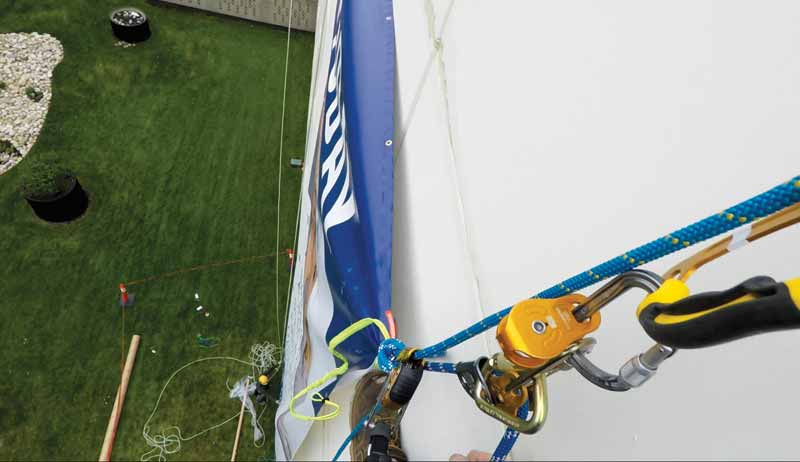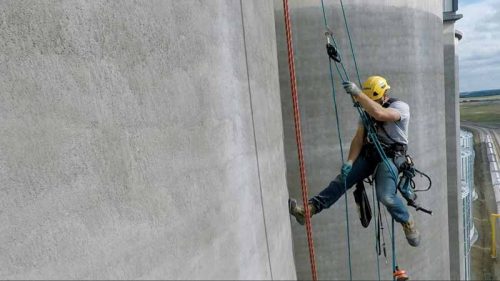Learning the ropes: Installation technique takes signs to new heights
by | 25 October 2019 10:19 am
By Max Jaffray
 [1]
[1]A banner being hauled up with ropes using mechanical advantage and specialty equipment.
Large sign installation can provide jaw-dropping visuals that are sure to attract the attention of potential consumers. The windows of high-rise buildings can become a bold statement, while a mural engulfing the side of a five-storey building can catch the eye of every passerby. With advancements in the sign installation industry, it is possible to install a 9-m (30-ft) plus fascia sign or a banner that spans the size of a two-storey building. With the many possibilities of sign installation, the method in which the projects are completed has become increasingly important. Compared to other installation methods, rope access techniques allow highly trained professionals to increase efficiency and safety, all while expanding the available sign options for the client and reducing disruptions to the building.
Also known as industrial climbing, this installation technique is a form of work positioning, initially developed from techniques used in climbing and caving, which applies practical rope work to allow workers to access difficult-to-reach locations without the use of scaffolding, cradles, or an aerial work platform. Technicians descend, ascend, and traverse ropes for access and work while suspended by their harness. Sometimes a work seat may be used. The support of the rope is intended to eliminate the likelihood of a fall altogether, but a back-up fall arrest system is used in case of the unlikely failure of the primary means of support. This redundancy system is usually achieved by using two ropes—a working line and a safety line.
How rope access is advancing the sign industry
The current state of high-rise sign installation can be complex in nature, efficiency, and safety. Swing stage scaffolding involves a platform suspended from a building using either ropes or cables. Large equipment is often required, resulting in hours of additional setup and take down time being charged to the client. For larger projects, these steps may need to be done numerous times to move to the next section of the project. Using a swing stage for sign installation can be expensive and lead to damage to the building. It can also increase the danger involved in the installation. Some swing stage companies will perform the install themselves; although this is rare, if offered, it comes at a much higher cost. In other cases, they will train the installation company’s staff on how to work the swing stage. After training, they will rig the swing stage with outriggers and heavyweights, allowing the sign company’s staff to complete the project themselves. That said, minimum training and lack of experience can lead to the improper use of the equipment and increased likelihood of an accident.
- Safety
Rope access sign installation consists of highly trained professionals who are prepared for potential emergency situations and trained in the necessary rescue procedures. At all times, an individual trained in first aid and CPR will be on-site during the project. Rope access professionals have 2000-plus hours on the ropes during which they are subject to a high standard of training. A two-rope system is always used, providing a failsafe backup in case of error or malfunction. The completion of an annual equipment maintenance inspection report is required, as is the regulatory compliance for personal protective equipment (PPE), and a daily hazard assessment.
- Accessibility
Rope access broadens the scope of sign installation by providing professionals the ability to reach in and around corners, over and under bridges, along rooftops, and more. Further, it dramatically reduces the restrictions that bucket trucks and lifts experience when they are unable to get close enough to the installation site due to the surroundings. The use of specific anchors also enables sign installers to access hard-to-reach areas, while maintaining an increased level of safety.
- Cost
Rope access eliminates the need for swing stage rentals, bucket trucks, or lifts, reducing overhead costs and labour hours for sign installation companies. Without the extra time needed for setup and take down, the cost of a project completed using the rope access method can be much less than that of swing stage installation.
Typically, when using a lift, it will take approximately 14 hours to complete a sign installation (depending on the project of course). Whereas, the rope access technique will allow an installer to finish the project in less than nine hours. If swing stage scaffolding is used, it could take up to 32 hours to finish the install.
- Sustainability
 [2]
[2]Rope access technician using a hauling system to lift aluminum composite panels (ACP) up a 36.5-m (120-ft) grain elevator.
As rope access requires no machinery, no fuel is needed. By eliminating the need to use fossil fuels, sign installs can be completed in an environmentally friendly manner. This alone can provide a massive incentive to many clients.
- Efficiency
As mentioned earlier, by using the rope access sign installation method the time needed to complete a project can be drastically reduced by reducing the amount of time required for the setup and take down of a project. Rope access promotes efficiency and allows the sign to reach its maximum viewing potential.
- Adaptability
Lift equipment and bucket trucks, due to the nature of the machinery, can take up a lot of space. Rope access allows a multitude of projects to be completed without having to block off large areas, leading to traffic congestion and difficulty accessing the building. To avoid negatively obstructing clients and staff, it is essential to have the least amount of disruptions to the building. Esthetically, rope access sign installation beats out competitors by reducing the “construction zone” look and maintaining the building’s original design.
- Maintenance
Ongoing maintenance to a sign can become
a time-consuming and hazardous job with the use of other methods, but not with the rope access technique. In fact, this installation method makes it much easier to reach the sign and perform any needed maintenance with minimal impact on the building.
With the many advantages of using rope access methods for sign installation, the safety of workers, and the speed of project completion provide profound differences from other methods. Minimal impact on surrounding areas, the expansion of project options for clients, and the ability to reduce the time needed to install a sign ensure rope access allows installers to guarantee customer satisfaction and worker safety.
The high standard of training results in professionals who are fully equipped to successfully complete even the most difficult of projects, all while reducing cost and maximizing return. Rope access is changing the sign installation industry and opening the door to a multitude of new opportunities and ideas. With its capabilities and impressive safety record, rope access is the future of the sign installation industry.
Max Jaffray is the owner of Hi-Vis Media Installations, which installs signs, banners, decals, and building wraps. Contact him via e-mail at max@hivismedia.ca. For more information, visit www.hivismediainstallations.ca.
- [Image]: https://www.signmedia.ca/wp-content/uploads/2019/10/banner-install1.jpg
- [Image]: https://www.signmedia.ca/wp-content/uploads/2019/10/Hauling-System.jpg
Source URL: https://www.signmedia.ca/learning-the-ropes-installation-technique-takes-signs-to-new-heights/